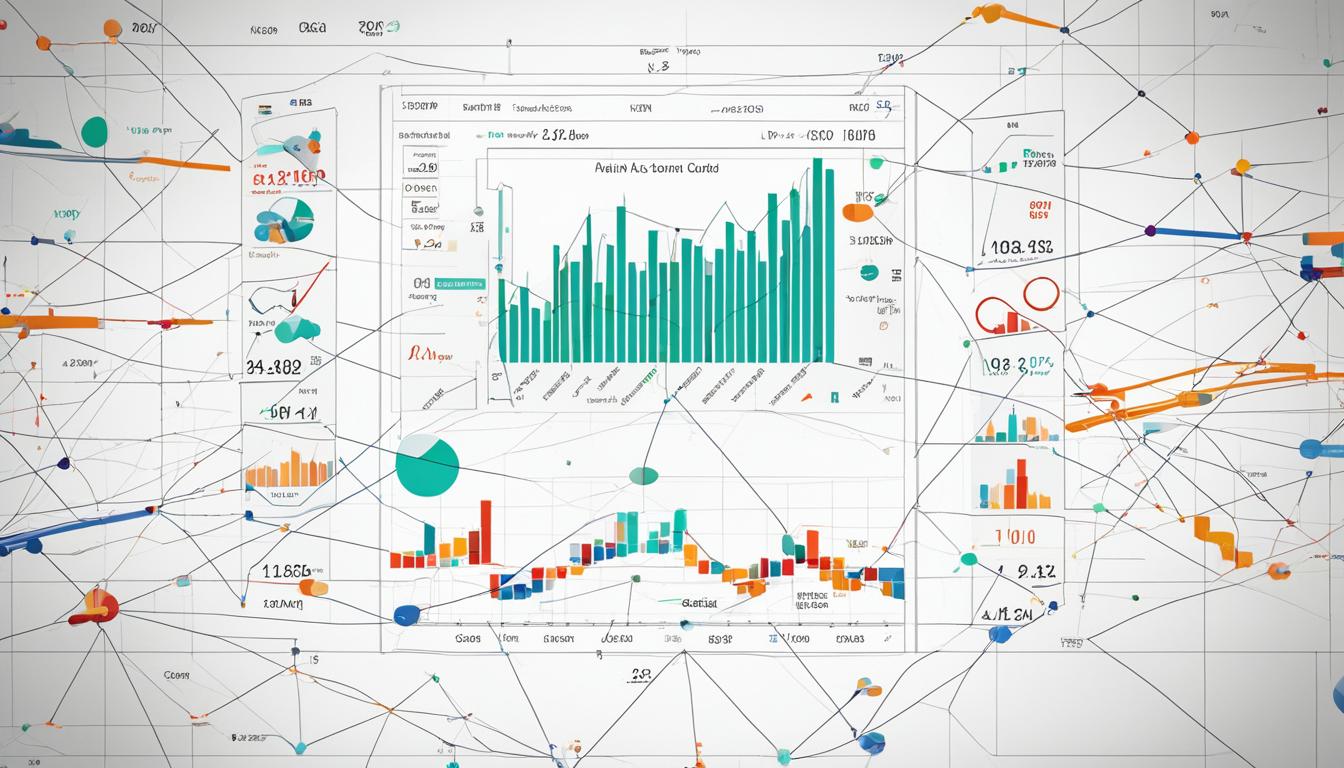Expert Insights on Financial Market Analysis
Financial market analysis is a vital component of successful investment strategies. It involves studying market trends, analyzing economic indicators, and utilizing various analysis techniques to make informed decisions. Whether you’re a seasoned investor or a beginner looking to navigate the stock market, understanding financial market analysis is crucial for maximizing returns and managing risks.
At MarketScreener, we provide expert insights and analysis on all aspects of financial market analysis. From understanding the stock market to analyzing economic indicators and forecasting financial trends, our goal is to empower investors with the information they need to make educated investment decisions.
Key Takeaways:
- Financial market analysis involves studying market trends, economic indicators, and utilizing various analysis techniques.
- Understanding the stock market and its analysis techniques is essential for making informed investment decisions.
- Economic indicators provide insights into the overall health of the economy and help predict market trends.
- Financial forecasting helps investors and businesses allocate resources effectively and manage risks.
- Market research provides valuable insights for making informed financial decisions and developing effective investment strategies.
Understanding Stock Market Analysis
Stock market analysis is a crucial part of financial market analysis. It involves studying market trends, analyzing stock performance, and identifying investment strategies. Both technical analysis and fundamental analysis contribute to understanding market behavior and making informed investment decisions.
Technical analysis focuses on price charts and patterns, utilizing historical data to predict future price movements. By examining trends, support and resistance levels, and various indicators, technical analysts seek to identify optimal entry and exit points for trades.
Fundamental analysis, on the other hand, takes a deep dive into a company’s financial health, management team, competitive position, and industry trends. By evaluating these factors, fundamental analysts aim to determine the intrinsic value of a stock and identify potential investment opportunities.
Combining both technical and fundamental analysis provides investors with a comprehensive understanding of the stock market. It helps them gauge the overall market sentiments, identify potential entry and exit points, and make informed decisions based on data-driven insights.
Economic Indicators for Financial Analysis
Economic indicators are key factors that provide insights into the overall health of an economy and help predict market trends. They play a significant role in financial market analysis, enabling investors and analysts to make informed decisions and develop effective investment strategies.
Some of the essential economic indicators include:
- Gross Domestic Product (GDP) growth rate: The GDP growth rate measures the increase in economic activity within a country during a specific period. It reflects the overall health and performance of the economy.
- Inflation rates: Inflation is the rate at which the general level of prices for goods and services rises and, consequently, how purchasing power falls. Tracking inflation rates helps investors understand the impact of rising costs on various sectors and anticipate changes in consumer behavior.
- Employment data: Employment data provides insights into the labor market, including the unemployment rate, job creation, and workforce participation. It is an essential indicator for assessing the overall economic stability and consumer confidence.
- Consumer spending: Consumer spending plays a vital role in driving economic growth. Monitoring consumer spending patterns helps investors understand the demand for goods and services and identify potential investment opportunities in different industries.
The Role of Economic Indicators
Economic indicators act as critical tools for financial analysis by providing valuable information on the current state of the economy and its future trajectory. Analysts and investors analyze these indicators to:
- Assess market trends: Economic indicators help identify economic cycles, such as expansions, contractions, and recessions. By tracking indicators over time, investors can identify market trends, anticipate changes, and adjust their investment strategies accordingly.
- Evaluate investment opportunities: Understanding the current economic conditions is crucial for selecting the right investment opportunities. Economic indicators provide insights into the performance of different sectors and industries, helping investors identify potential growth areas or areas of risk.
- Manage risks: Economic indicators help investors assess the risk associated with their investments. By monitoring indicators such as inflation rates, interest rates, and employment data, investors can make informed decisions to manage and mitigate risks effectively.
- Inform financial forecasting: Economic indicators serve as essential inputs for financial forecasting models. By analyzing these indicators and understanding their impact on market behavior, analysts can make accurate predictions about future market trends.
Overall, economic indicators play a crucial role in financial market analysis, providing valuable insights into the state of the economy and guiding investment decisions. By staying informed about key economic indicators and their impact on market trends, investors can develop effective strategies to navigate the dynamic financial landscape.
The Importance of Financial Forecasting
Financial forecasting plays a crucial role in the field of financial market analysis. It enables investors and businesses to make informed decisions, allocate resources effectively, and manage risks. By predicting future market trends, company performance, and investment opportunities, accurate financial forecasting provides valuable insights for strategic planning.
One of the key benefits of financial forecasting is its ability to identify potential growth areas. By analyzing market trends and economic indicators, investors can spot emerging sectors and seize opportunities before they become mainstream. This proactive approach allows for early entry into promising markets, maximizing returns and gaining a competitive advantage.
“Financial forecasting enables businesses to adjust their strategies and allocate resources effectively, ensuring optimal performance and sustainability in dynamic market conditions.”
Moreover, financial forecasting is instrumental in portfolio analysis. By predicting the future performance of investments, investors can make informed decisions on asset allocation and risk management. This strategic approach balances potential returns with risk aversion, ensuring a well-diversified portfolio that aligns with individual financial goals and market trends.
The Role of Financial Forecasting in Risk Management
Accurate financial forecasting also helps in identifying and mitigating potential losses. By assessing various scenarios and conducting sensitivity analyses, investors can prepare for possible downturns and build robust risk management strategies. This proactive approach minimizes the impact of market volatility and safeguards investments.
Financial forecasting uses various quantitative methods, including statistical models, time series analysis, and regression analysis, to predict future trends accurately. Additionally, it incorporates qualitative factors such as industry research and expert opinions, providing a comprehensive outlook on potential market shifts.
Financial forecasting also guides businesses in allocating resources effectively. It helps determine the optimal utilization of funds, identifying areas of over or underinvestment. By aligning resources with market demands, businesses can streamline operations, minimize costs, and optimize productivity.
The Benefits of Accurate Financial Forecasting:
- Strategic decision-making
- Effective resource allocation
- Risk management
- Proactive market positioning
- Improved portfolio performance
Accurate financial forecasting is a powerful tool that empowers investors and businesses to navigate the complex financial landscape. By analyzing past trends, assessing current market conditions, and predicting future outcomes, financial forecasting enables stakeholders to make well-informed decisions, capitalize on opportunities, and achieve their financial goals.
The Role of Market Research in Financial Analysis
Market research plays a vital role in financial market analysis, providing valuable insights for investors and analysts. By gathering data, analyzing consumer behavior, and assessing market trends, market research helps identify potential opportunities and understand customer needs in order to develop effective investment strategies.
Investors rely on market research to evaluate the competitive landscape and make informed financial decisions. By understanding market trends, they can identify emerging sectors, assess the demand for specific products or services, and position their investments accordingly. Market research also helps investors evaluate the potential risks and rewards associated with different investment options.
Furthermore, market research provides a comprehensive view of the financial landscape, enabling investors to assess industry trends, competitive positioning, and consumer preferences. Armed with this information, investors can make well-informed decisions and adapt their investment strategies to capitalize on market trends and changing consumer behavior.
One example of the power of market research in financial analysis is the analysis of market trends. By studying consumer preferences and purchasing patterns, investors can identify growing market segments and allocate resources accordingly. Market research also helps investors identify potential risks, such as changes in consumer behavior or evolving market dynamics, and develop strategies to mitigate these risks.
Market Research Methods
Market research involves a variety of methods to gather and analyze data. These methods include surveys, focus groups, interviews, and data analysis techniques. Surveys allow researchers to collect large amounts of data from a wide range of participants, providing quantitative insights into market trends and consumer preferences. Focus groups and interviews, on the other hand, provide qualitative insights by allowing researchers to delve deeper into consumer behavior and opinions.
Data analysis techniques are used to analyze and interpret the collected data, uncovering patterns and trends that can inform investment strategies. These techniques may include statistical analysis, data visualization, and predictive modeling. By utilizing these methods, investors can gain a comprehensive understanding of the market and make data-driven decisions.
Case Study: Market Research in Action
Let’s consider a case study that highlights the importance of market research in financial analysis. Company XYZ, a tech startup, is considering expanding its product line into the wearable technology market. Before making any investment decisions, XYZ conducts thorough market research to assess the potential demand, competitive landscape, and consumer preferences.
The market research reveals a growing trend in wearable technology, with increasing consumer adoption and a surge in demand for smartwatches. XYZ also identifies key competitors in the market and analyzes their product offerings, pricing strategies, and customer satisfaction levels. Armed with this information, XYZ can evaluate the viability of expanding its product line and develop an effective market entry strategy.
| Key Findings from Market Research | Implications for XYZ |
|---|---|
| Growing trend in wearable technology | Opportunity to capture a share of the expanding market |
| Increasing consumer adoption of smartwatches | Potential demand for XYZ’s wearable technology products |
| Key competitors with established market presence | Need for competitive differentiation and pricing strategy |
Based on the market research findings, XYZ decides to proceed with the expansion into the wearable technology market. They develop innovative products that cater to specific customer needs and differentiate themselves from competitors. XYZ’s market research-driven approach enables them to make informed investment decisions and position their products effectively in the market.
Market research provides critical insights for financial market analysis, enabling investors to understand market trends, identify potential opportunities, and develop effective investment strategies. By leveraging market research methods and analyzing the collected data, investors can make informed decisions and capitalize on market trends, ultimately maximizing their returns.
Analyzing Portfolio Performance
One of the crucial aspects of financial market analysis is portfolio analysis. It provides investors with valuable insights into the performance of their investment portfolio, enabling them to make informed decisions. By analyzing the risk and return profile of their holdings, investors can optimize their returns and align their portfolio with their financial goals and market trends.
When conducting portfolio analysis, investors focus on several key factors:
- Diversification: Assessing the diversity of investments within the portfolio helps mitigate risks associated with market volatility. It involves spreading investments across various asset classes, sectors, and geographical regions, reducing the impact of specific market fluctuations on the overall portfolio performance.
- Asset Allocation: Determining the appropriate mix of different asset classes, such as stocks, bonds, and commodities, is crucial in optimizing returns and managing risk. Asset allocation is based on factors like risk tolerance, investment horizon, and market conditions.
- Performance Evaluation: Regularly monitoring the performance of each investment in the portfolio helps identify underperforming assets. By conducting in-depth financial analysis and comparing investment returns against industry benchmarks, investors can make informed decisions regarding the retention, diversification, or disposal of specific holdings.
Furthermore, portfolio analysis can involve assessing other metrics, such as volatility, correlation, and liquidity, to gain a comprehensive understanding of the portfolio’s dynamics and risk exposure.
“Portfolio analysis enables investors to identify underperforming assets, rebalance their holdings, and diversify their investments.”
Investors can use various tools and techniques to conduct portfolio analysis. Some common approaches include:
- Modern Portfolio Theory: This theory emphasizes the importance of diversification and the relationship between risk and return. It helps investors identify the optimal combination of assets that maximizes returns for a given level of risk.
- Portfolio Performance Measurement: This involves evaluating the overall performance of the portfolio using metrics like the Sharpe ratio, which measures risk-adjusted returns.
- Scenario Analysis: By simulating different market scenarios and assessing their impact on the portfolio, investors can gauge the resilience of their holdings and make informed decisions under various market conditions.
- Monte Carlo Simulation: This technique uses statistical modeling to generate thousands of possible outcomes based on input assumptions. It provides investors with a range of potential portfolio performance scenarios, enabling them to make more informed decisions.
The ultimate goal of portfolio analysis is to optimize the risk and return profile of the investment portfolio, ensuring that it aligns with the investor’s financial objectives and the prevailing market trends.
Example Portfolio Analysis
To illustrate the process of portfolio analysis, consider the following hypothetical example:
| Asset | Allocation | Return |
|---|---|---|
| Stocks | 60% | 12% |
| Bonds | 30% | 5% |
| Commodities | 10% | 8% |
In this example, the investor has allocated 60% of their portfolio to stocks, 30% to bonds, and 10% to commodities. They have achieved a return of 12% from stocks, 5% from bonds, and 8% from commodities. By analyzing this portfolio, the investor can evaluate the performance of each asset class against their expected returns and risk levels.
Based on the analysis, the investor may decide to rebalance the portfolio by adjusting the allocation percentages to optimize returns and manage risk. For example, if stocks have been performing exceptionally well and are now overrepresented in the portfolio, the investor may consider reducing the allocation to stocks and increasing the allocation to bonds or commodities.
By continuously analyzing and adjusting the portfolio’s performance, investors can ensure that their investments are aligned with their financial goals and market trends, maximizing their returns while managing risks.
Technical Analysis in Financial Market Analysis
Technical analysis plays a crucial role in financial market analysis, providing valuable insights into market trends and potential investment opportunities. By studying price charts, volume patterns, and indicators, technical analysts aim to predict future market movements and make informed investment decisions. Through the use of various tools and techniques, they identify key trends, support and resistance levels, and potential entry and exit points for trades.
One of the primary objectives of technical analysis is to identify patterns and trends in price movements. Chart patterns, such as head and shoulders, double tops, and descending triangles, provide visual cues that help analysts identify potential reversals or continuations in market trends. These patterns are derived from historical price data and can provide valuable information about the future direction of a security or market.
Another key aspect of technical analysis is the use of indicators. These are mathematical calculations applied to price and volume data to provide additional insights into market behavior. Common indicators include moving averages, relative strength index (RSI), and MACD (moving average convergence divergence). These indicators help analysts identify overbought or oversold conditions, trend strength, and potential buy or sell signals.
Tools of Technical Analysis
In addition to patterns and indicators, technical analysis employs various tools to facilitate analysis and decision-making. Some of these tools include:
- Trendlines: Trendlines are drawn on price charts to visualize the direction of a trend. They help analysts identify potential levels of support and resistance and determine the strength of a trend.
- Fibonacci retracement: Fibonacci retracement levels are used to identify potential support and resistance levels based on the Fibonacci sequence. These levels help analysts determine possible reversal points within a trend.
- Candlestick charts: Candlestick charts provide a visual representation of price movements, making it easier to identify patterns and trend reversals. Candlestick patterns, such as doji, hammer, and engulfing patterns, can provide insights into market sentiment.
By combining these tools and techniques, technical analysts strive to make accurate predictions about future price movements and market trends. This analysis can be used by traders to make short-term trades or by long-term investors to identify entry and exit points for their investments.
| Advantages of Technical Analysis | Limitations of Technical Analysis |
|---|---|
|
|
Despite its limitations, technical analysis remains a popular and widely used approach in financial market analysis. By understanding price patterns, indicators, and tools, investors can gain valuable insights into market trends and make informed decisions that align with their investment strategies.
Fundamental Analysis in Financial Market Analysis
Fundamental analysis is an essential approach in financial market analysis. It involves evaluating a company’s financial statements, management team, competitive position, and industry trends to determine its intrinsic value. By analyzing these factors, fundamental analysts gain insights into the long-term prospects of a company and make informed investment decisions.
One of the key methods used in fundamental analysis is ratio analysis, which involves calculating and comparing various financial ratios of a company. These ratios, such as price-to-earnings (P/E) ratio, debt-to-equity ratio, and return on equity (ROE), provide valuable insights into a company’s financial health and performance.
Financial modeling is another tool employed by fundamental analysts. It involves creating complex models that simulate and forecast a company’s financial performance based on different scenarios. This helps investors understand the potential risks and rewards associated with their investments.
The goal of fundamental analysis is to identify stocks that are undervalued or overvalued compared to their intrinsic value. By determining the true worth of a company, investors can make informed decisions on whether to buy, sell, or hold its shares.
“Fundamental analysis is like taking a magnifying glass to the financial statements of a company. It allows investors to see beyond the surface and evaluate the true value of a business.”
Fundamental Analysis vs. Technical Analysis
While fundamental analysis focuses on evaluating a company’s financials and industry trends, technical analysis takes a different approach. Technical analysts primarily rely on price charts, patterns, and indicators to predict future market movements. They believe that historical price data and market trends can provide valuable insights into future price movements.
While fundamental analysis is favored by long-term value investors, technical analysis is more commonly used by short-term traders. Both approaches have their advantages and limitations, and many investors use a combination of both to make well-rounded investment decisions.
The Importance of Fundamental Analysis
Fundamental analysis plays a crucial role in financial market analysis and investment strategies. It helps investors gain a deeper understanding of the underlying factors that drive a company’s value and performance. By analyzing financial statements, industry trends, and management capabilities, investors can make more informed decisions and minimize their risks.
Furthermore, fundamental analysis allows investors to identify market inefficiencies and take advantage of them. It helps investors uncover undervalued stocks that have the potential for significant growth, as well as overvalued stocks that may be ripe for a correction.
Overall, fundamental analysis provides a foundation for sound investment decision-making. By considering the fundamental characteristics of a company, investors can align their investments with market trends and position themselves for long-term success.
Emerging Trends in Financial Market Analysis
Financial market analysis is a dynamic field that continually evolves with emerging trends and technological advancements. Staying abreast of these trends is essential for investors and analysts to adapt their strategies and make informed decisions. Let’s explore some of the key emerging trends shaping the landscape of financial market analysis:
1. Utilizing Artificial Intelligence and Machine Learning
Artificial Intelligence (AI) and Machine Learning (ML) are revolutionizing financial market analysis by enabling advanced data analysis and predictive modeling. These technologies have the capability to process vast amounts of data, identify patterns, and generate insights at a speed and scale that surpass human capabilities. AI and ML algorithms can analyze market trends, optimize investment strategies, and even automate trading processes for enhanced efficiency and accuracy.
2. Rise of Sustainable Investing
As environmental, social, and governance (ESG) considerations gain importance, sustainable investing has emerged as a significant trend in financial market analysis. Investors are increasingly seeking opportunities that align with their values of sustainability and social responsibility. Utilizing ESG metrics and conducting thorough ESG analysis helps identify companies and investments that demonstrate strong sustainability practices, thereby mitigating risks and unlocking long-term value.
3. Integration of Big Data in Market Research
The abundance of digital data in today’s interconnected world presents extensive opportunities for market research. As financial market analysis becomes increasingly data-driven, the integration of big data analytics is playing a pivotal role. By leveraging vast amounts of structured and unstructured data from various sources, such as social media, web scraping, and sensor data, analysts can gain deeper insights into market trends, customer behavior, and industry dynamics, enabling informed decision-making.
Stay tuned as we delve into these emerging trends and explore their implications for financial market analysis. Understanding and adapting to these trends can provide invaluable insights and give investors and analysts a competitive edge in navigating the ever-changing financial landscape.
Key Takeaways:
- Artificial Intelligence and Machine Learning are driving advancements in financial market analysis, enabling advanced data analysis and predictive modeling.
- Sustainable investing is gaining momentum, integrating ESG considerations into investment strategies.
- Big data analytics is increasingly being utilized for market research, providing deeper insights into market trends and customer behavior.
Conclusion
Financial market analysis is a complex and dynamic field that plays a crucial role in making informed investment decisions. By closely monitoring market trends and analyzing economic indicators, investors and analysts can gain valuable insights into the ever-changing financial landscape. This information enables them to develop effective investment strategies and maximize returns.
Expert insights, such as those provided by MarketScreener, are invaluable in navigating the complexities of financial market analysis. Conducting thorough market research and utilizing various analysis techniques, such as technical and fundamental analysis, further enhance the decision-making process. These tools enable investors to assess the performance of their investment portfolios, identify potential growth areas, and manage risks effectively.
Staying informed and adaptable is key to success in financial market analysis. By continuously monitoring market trends, understanding economic indicators, and analyzing portfolio performance, investors can make well-informed decisions in an ever-changing financial landscape. Adopting a comprehensive approach that combines expert insights, market research, and analysis techniques is crucial for achieving sustainable growth and maximizing returns.







